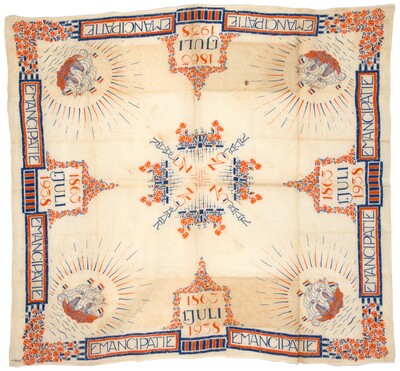Javascript must be enabled to continue!
Surinamese-Creole headscarf to commemorate the 75th anniversary of the abolition of slavery on July 1, 1863
View through Europeana Collections
Cotton headscarf commemorating the abolition of slavery on that date 75 years ago. In each corner, a sailing ship is flanked by roses; on the edges, the word "emancipation" is printed twice each with 1863 - July 1, 1938 in between. In the middle are again roses, from which four rays emerge, forming "75 years". Up to and including the celebration of 75 years of Emancipation, headscarves still show mainly Dutch glory-like motifs. Later, there is more awareness and chains frequently appear as a motif for keti-koti (van Putten and Zantinge, 1988:47). \The headscarf is worn by Creole women on July 1, but can also be hung on the wall as a decorative item or used as a tablecloth.The koto is a costume that originated in Suriname and was devised by slave owners and their wives to dress their slaves 'modestly'. The costume consists of a koto (skirt), jaki (jacket) and angisa (headscarf). The religion to which the slave owner belonged could be seen in the costume. Although it used to be everyday clothing, the koto later changed into casual clothing. The koto and especially the angisa spoke and speak a secret language (Henar-Hewitt, 1987:35).
National Museum of World Cultures Foundation
Title: Surinamese-Creole headscarf to commemorate the 75th anniversary of the abolition of slavery on July 1, 1863
Description:
Cotton headscarf commemorating the abolition of slavery on that date 75 years ago.
In each corner, a sailing ship is flanked by roses; on the edges, the word "emancipation" is printed twice each with 1863 - July 1, 1938 in between.
In the middle are again roses, from which four rays emerge, forming "75 years".
Up to and including the celebration of 75 years of Emancipation, headscarves still show mainly Dutch glory-like motifs.
Later, there is more awareness and chains frequently appear as a motif for keti-koti (van Putten and Zantinge, 1988:47).
\The headscarf is worn by Creole women on July 1, but can also be hung on the wall as a decorative item or used as a tablecloth.
The koto is a costume that originated in Suriname and was devised by slave owners and their wives to dress their slaves 'modestly'.
The costume consists of a koto (skirt), jaki (jacket) and angisa (headscarf).
The religion to which the slave owner belonged could be seen in the costume.
Although it used to be everyday clothing, the koto later changed into casual clothing.
The koto and especially the angisa spoke and speak a secret language (Henar-Hewitt, 1987:35).
Related Results
Model of a Surinamese Creole headscarf
Model of a Surinamese Creole headscarf
Model of a Surinamese headscarf folded into a fan, fan-ede. \Angisa's are starched cotton printed cloths. Through these headgear women in Suriname passed 'secret' (though known to ...
Cotton Surinamese Creole headscarf folded in the French manner
Cotton Surinamese Creole headscarf folded in the French manner
Folded according to the French manner, the headscarf is printed with ribbons and loops, with a heart with a key in it.‖ Through these headgear, women in Suriname passed 'secret' (t...
Model of a Surinamese Creole headscarf
Model of a Surinamese Creole headscarf
Model of a Creole headscarf, folded to form 'otto bakka', a car bumper. The motifs are derived from Indonesian batik, called Yampanesi. \The motifs are derived from Indonesian bati...
Model of a Surinamese Creole headscarf
Model of a Surinamese Creole headscarf
Green and blue headscarf with a name that refers to the owner or perhaps the inventor of this folding method: \"Miss Valies hiddi".\Angisa's are starched cotton printed cloths.Thro...
Model of a Surinamese Creole headscarf
Model of a Surinamese Creole headscarf
A model of a headscarf from Suriname, folded into a 'car bumper'.‖ Through these headgear, women in Suriname transmitted 'secret' (though known to all 'insiders') messages to each ...
Model of a Surinamese Creole headscarf
Model of a Surinamese Creole headscarf
Creole headscarf, folded in 'curly tail'.‖ Through these headgear, women in Suriname passed 'secret' (though known to all 'insiders') messages to each other through various ways of...
Model of a Surinamese Creole headscarf
Model of a Surinamese Creole headscarf
Model of a 'car bumper'. \oto-baka folded headscarf, angisa.‖ Through these headgear, women in Suriname passed 'secret' (though known to all 'insiders') messages to each other thro...
Model of a Surinamese Creole headscarf
Model of a Surinamese Creole headscarf
Multicolored model of a headscarf folded into a "curly tail."‖ Angisa are starched cotton printed cloths.Through these headgear, women in Suriname passed "secret" (though known to ...




